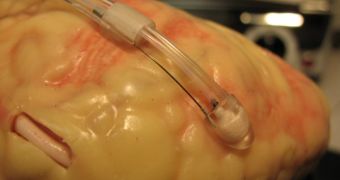A caterpillar is the larval form of some insects, like butterflies and moths. They eat mostly plants and sometimes even other insects. They have many legs (three pairs of true legs on the three thoracic segments, up to four pairs of prolegs on the middle segments of the abdomen and often a single pair of prolegs on the last abdominal segment) and tiny hairs to detect vibrations.
They are usually considered as pests, and many people find them disgusting.
Leaches, particularly medicinal ones (Hirudo medicinalis), have been used for clinical bloodletting for thousands of years and even now, alternative medicine consider them an ally.
So, they're good, but most people find them disgusting as well.
How about a "caterpillar robot" that crawls over the surface of a beating heart to deliver drugs or other treatments?
Repulsive, but good!
Named HeartLander, the device is just two centimeters long and can move up to 18 centimeters per minute controlled by a joystick outside the body.
The research team claims that the robot could help doctors repair damaged heart without invasive surgery.
"It avoids having to disturb the ribcage, or to deflate the left lung to access the heart," said Cameron Riviere who led the research. He also added there is no need to stop the heart, and the device can be implanted directly onto the heart rather than having to go past the lungs. "This could benefit patients in other ways. Since the operation doesn't need general anesthetic, patients may be able to go home the same day," the team said.
The open heart surgery in bypass operation can be a traumatic experience for the patient and can take weeks for recuperation.
The robot is inserted under the patient's ribcage by a keyhole surgery and attached to the heart via a vacuum line attached to the suckers. The caterpillar robot walks with suction feet attaching to the surface and the movement is controlled by push-and-pull wires outside the body. The robot can inject stem cells and growth factor genes and take tissue samples from the heart's surface using a needle.
The device has already been tested on a living pig. During the applications it was found that the device could easily navigate its way around a pig's heart and could reach the back of the organ. It was also found that the robot's movement did not affect the heart's rhythm, nor did it cause any damage.
Experiments would be conducted with a sheep's heart before testing the device on human cadavers. Dr Riviere hopes the HeartLander to be available for surgical use within three to four years.

 14 DAY TRIAL //
14 DAY TRIAL //